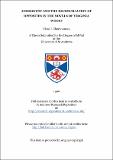Androgyny and the reconciliation of opposites in the novels of Virginia Woolf
Abstract
The purpose of the following study is to demonstrate that Virginia Woolf's belief in the theory of androgyny is not merely a "flirtation", as Lyndall Gordon asserts, but, rather, that it is the focus of her artistic and personal vision. The study consists of five chapters, prefaced by an introduction to the artist's perspective and the early androgynous approaches of her first novels. Attention is given to each of Woolf's novels, some of which have been given a more extensive examination than others. Virginia Woolf's diaries, letters, essays and sketches are used where appropriate to develop this study of the novels. The first three chapters, on Mrs. Dalloway, To the Lighthouse, and Orlando, trace the movement of several protagonists toward their individual knowledge of the composite self. The study of Woolf's theory in Chapter Four combines both The Waves and The Years into a consideration of androgyny primarily as the unifying force within the world at large, rather than as a private vision toward which one struggles. The dissertation concludes with a study of Woolf's final novel. Between the Acts, which brings the androgynous approach of the earlier novels to its culminating vision.
Type
Thesis, MPhil Master of Philosophy
Collections
Items in the St Andrews Research Repository are protected by copyright, with all rights reserved, unless otherwise indicated.

